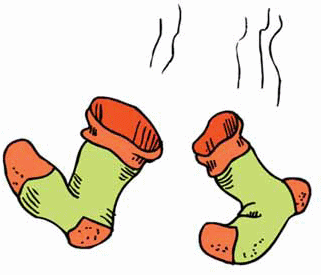SEJournal Online is the digital news magazine of the Society of Environmental Journalists. Learn more about SEJournal Online, including submission, subscription and advertising information.
Science Survey
By RAE TYSON
 Stinky socks may be socially embarrassing, but aren’t in the same league as other pressing environmental issues. On the other hand, there may well be a connection between odor-resistant socks and an emerging health and environmental concern.
Stinky socks may be socially embarrassing, but aren’t in the same league as other pressing environmental issues. On the other hand, there may well be a connection between odor-resistant socks and an emerging health and environmental concern.
Scientists, environmentalists and regulators alike are increasingly concerned about nanosilver — microscopic particles that are now used for bacterial control in well over 1,000 consumer products. These include toys, cosmetics, sunscreen, air and water filters, household cleaners, clothing and washing machines. One increasingly common use of nanosilver is in athletic socks to minimize offensive smells.
Though research is inconclusive, scientists have found evidence that nanosilver, once in the environment — most commonly in wastewater effluent — can potentially bioaccumulate in organisms such as earthworms, insects and fish. Studies also suggest that nanoparticles in soil can harm plants.
Uncertainty about the hazards of nanosilver is related to size. Silver in larger particles is known to be toxic. But in silver nanoparticles, which are about one billionth of a meter across, the effects are not fully understood. The scientific community, with federal funding, is scrambling to find the answers.
Some of the findings are raising concerns about nanosilver in products.
For example, in a new study on the effects of low levels of nanosilver on roundworms, researchers at Duke University discovered that not only did the material bioaccumulate — it also got passed on to offspring.
“The fact that [nanosilver particles] were transferred to the next generation also raises the question of what effects such exposure might have on offspring, especially since early development is frequently a time of particular vulnerability to exposure to toxic substances,” said the study by Duke University’s Nicholas School of the Environment and Center for the Environmental Implications of NanoTechnology.
Meanwhile, University of Utah scientists exposed zebrafish to low levels of nanosilver, which resulted in physical malformations and, in some cases, death.
In announcing the findings in 2009, Utah researcher Darin Furgeson told Environmental Health News that “we may have jumped the gun” with the proliferation of nanosilver in consumer products.
The impact of low levels of nanosilver on human health, if any, is unknown. But a recent study by the National Nanotechnology Center in Thailand evaluated the potential for human exposure to nanosilver. Researchers there found that people might possibly absorb silver nanoparticles through their skin. “Fabrics laced with silver nanoparticles designed to limit bacterial growth release those particles when the fabric is exposed to artificial human sweat,” they reported.
Some researchers are urging caution about the growing use of nanosilver. Troy Benn and colleagues at Arizona State University warned: “Because government does not specifically regulate the use of nanosilver in products, the onus of protecting human and environmental health from potential adverse effects currently falls on individuals. This research demonstrates that consumers will subject themselves and/or the environment to some exposure of silver (nanoparticle, ionic, or microscale) by using and/or disposing of silver-containing products.”
For its part, industry dismisses recent concerns about nanosilver, saying silver has been safely used in an array of products for years.
“Nanosilver is an old material with a multi-decade history of safe use demonstrated by significant bodies of data and experience drawn from real-life use,” said the Silver Nanotechnology Working Group, an industry organization.
Amid the controversy, the U.S. Environmental ProtectionAgency has been evaluating the effects of nanosilver on human health and the environment. The agency regulates products that kill or inhibit the growth of microorganisms — including nanosilver — as pesticides under the Federal Insecticide, Fungicide & Rodenticide Act. Through this law, EPA is asking product manufacturers to conduct more tests on nanosilver.
In August 2010, the agency proposed to conditionally register a product containing nanosilver as an active ingredient — that’s the part of a pesticide that actually harms a pest, including bacteria. The antimicrobial product, called HeiQ AGS-20, is proposed for use as a textile preservative.
As a condition of registration, EPA proposed to require the manufacturer to conduct toxicology, exposure, environmental, and other tests then turn the results over to regulators. “The agency will evaluate these data as they are submitted during the period of the conditional registration to confirm the product will not cause unreasonable adverse effects to human health and the environment,” EPA said. The agency is expected to make a final decision on the testing requirements in 2011.
Rosalind Volpe, executive director of industry’s Silver Nanotechnology Working Group, said the research requirements proposed by EPA are “onerous.” She added, “There is a lot of work that will have to be done.”
Keep your eyes open for scientific developments around silver nanoparticles, which are increasingly entering commerce in everyday products your audience uses. Non-stinky sock stories can be tailored to local, regional, national and international news outlets.
Rae Tyson is a veteran journalist and co-founder of SEJ. Currently on the staff of Environmental Health News, Tyson lives in an old farmhouse near Gettysburg, Pa.
Science Survey Bibliography:
- August 2010: Scientific American: “Silver Beware: Antimicrobial Nanoparticles in Soil May Harm Plant Life”
- September 2010: Journal of Environmental Quality: “The Release of Nanosilver from Consumer Products Used in the Home”; “Environmental Occurrences, Behavior, Fate, and Ecological Effects of Nanomaterials”
Science Survey Sources:
- California NanoSystems Institute
- Duke Center for the Environmental Implications of NanoTechnology
- Environmental Protection Agency
- Environmental Working Group: (202) 667-6982
- Project on Emerging Nanotechnologies
- Silver Nanotechnology Working Group: Rosalind Volpe, executive director, (919) 361-4647 x3023
- University of California Center for Environmental Implications of NanoTechnology
* From the quarterly newsletter SEJournal, Winter 2010-11 issue.













 Advertisement
Advertisement 



